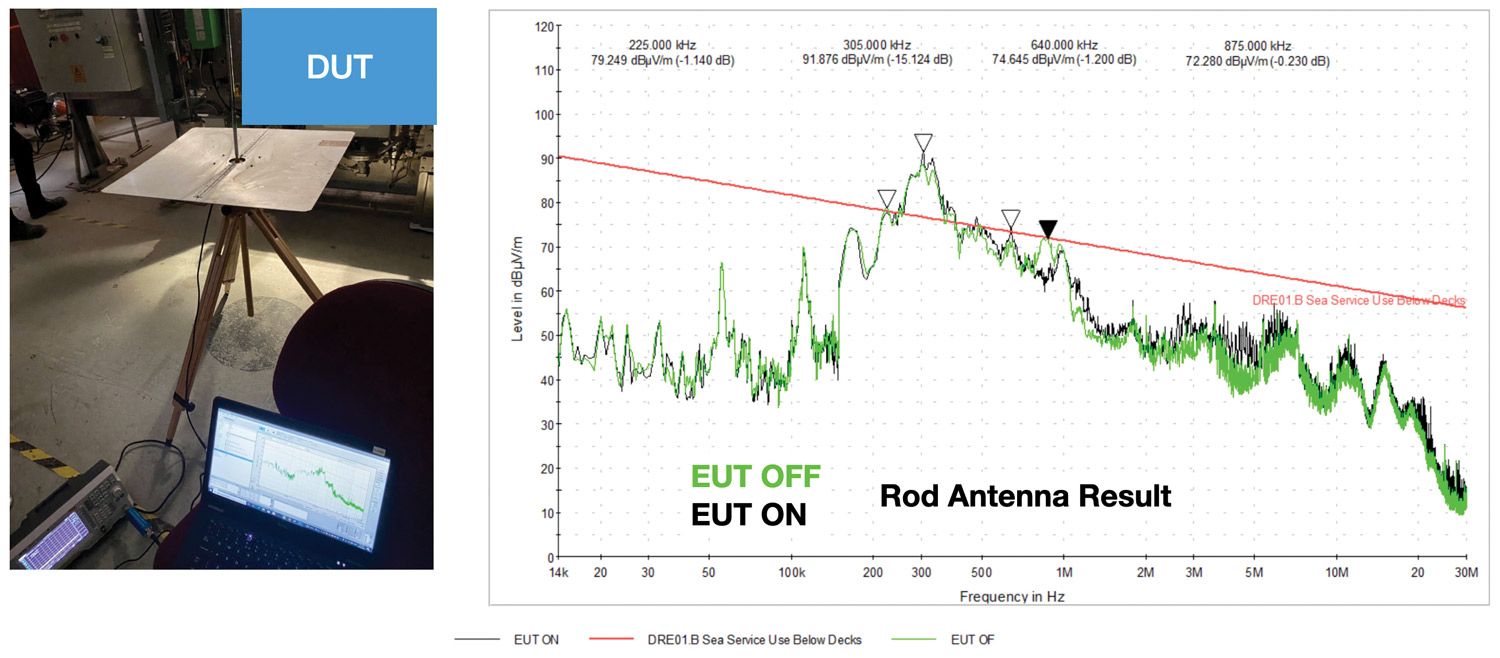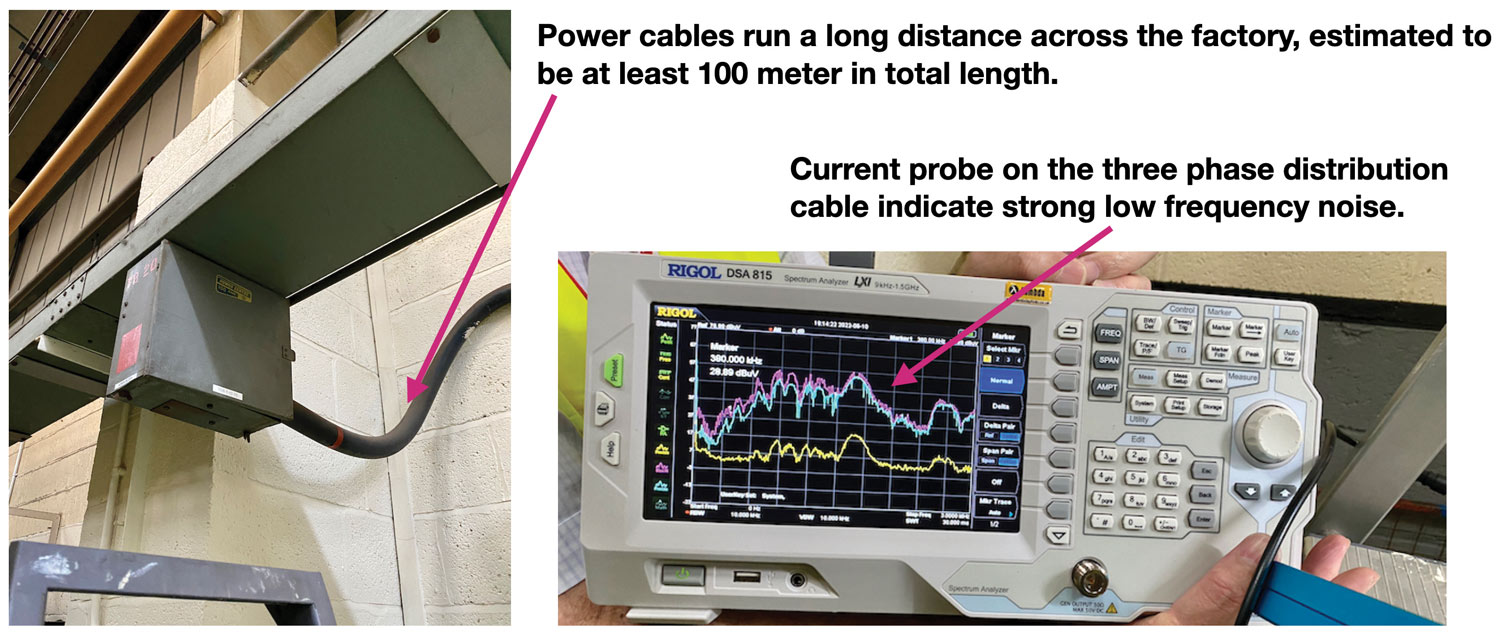n AM radio can be useful for finding both radiated emissions and ESD events. The biggest advantage of using a radio in EMC engineering is its cost (A second-hand AM radio on eBay costs about 20 USD or less). Understanding how radio works is essential for engineers to use this low-cost technology to troubleshoot complex EMI issues.
Using an AM Radio to Locate Emission Sources
The client’s product was a large-size installation located at their factory site. To perform an in-situ EMC test on the EUT, they shut down most of the equipment and lighting during the weekend, but the ambient noise at the site was still large enough to cause issues. Even when the EUT was powered off, the ambient environment exhibited a noise level higher than the limit line defined by the standards (in this case, the EUT was being tested against defense standard DEF STAN 59-411). This can be clearly seen in the results while performing a low-frequency radiated emission scan using a rod antenna (see Figure 1).
It was essential to locate the source of the noise and shut it down for the in-situ EMC test. Holding a large-size rod antenna together with the spectrum analyzer and walking in a large factory site proved to be difficult. My handheld spectrum analyzer (a TTI PSA6005) only works from 10 MHz and was, therefore, incapable of tracking down the noise source (although the noise source could radiate to a much higher frequency range). Another tool, a Credence Technologies EM Eye (now part of 3M), also works from 1 or 2 MHz.
In this case, I decided to use a Tecsun PL660 portable radio, tuned it to an AM station, and walked about in the factory. I expected the noise level picked up by the radio would increase when we approached the noise source.
There are three antenna gain settings with my radio, and I selected “DX” for the troubleshooting process. The other two options, “Normal” and “Local,” reduce background noise or interference, which was the opposite of what we wanted in this case.
AM radios with envelope detectors respond to radiated EMI from current impulses such as lightning, sparks, and magnetic field radiating from a conductor where dI/dt is large. The discriminator in a vintage FM radio is basically an AM envelope detector preceded by a filter with a linear ramp frequency response. The filter converts instantaneous frequent deviations in the program to amplitude deviations, which are then demodulated by the envelope detector. Such detectors are susceptible to impulse noise, especially if preceding stages are not driven into compression via hard limiting or amplifier clipping.
Modern FM receivers, which use phase-locked loops (PLLs) to implement the detection function, are much less susceptible to impulse noise. However, any FM receiver with an automatic gain control (AGC) may also be susceptible, as the constantly changing RF level induced by the EMI will cause the AGC to constantly react, throttling the receiver gain back in response to each impulse.
When I walked past the area, the radio receiver picked up huge audible noise. It turned out that the culprit was the three-phase power distribution cable located in a cable tray 3 meters above the factory floor.
To confirm this, an RF current monitoring probe was then used to measure the common mode noise on the cable bundle. The noise profile measured using the RF current probe was very similar to what we measured using the rod antenna. The cables were estimated to be about 100 meters in total length, forming a large loop that could radiate strongly at the low-frequency range (500kHz, for instance). The noise disappeared when the power to this part of the distribution line was cut off.
The case study discussed previously shows that an AM radio can be used to locate low-frequency radiated noise sources. But the same radio can also be used to help troubleshoot EMI noise at much higher frequencies when selecting the FM band. Modern switched-mode power supplies used in LED lights and compact fluorescent light bulbs are all “nasty” EMI sources. I fixed the radiated emission issues of an LED light with the help of a radio. After the fix, the radio can be played without issues when it is placed near the LED light. (See the YouTube video https://youtu.be/fkNa-FejWsQ that demonstrates the point).
A Useful Tool for ESD Detection
AM radios are also useful for detecting ESD events, as explained previously. “Pops” in the radio serve as good evidence that nearby ESD events are generating sparks.2 I used an AM radio to locate an ESD problem at a factory site in another situation. In that particular case, when we switched off the lights and kept the room in the dark, we could see the sparks in the dark while listening to the “pops” in the radio receiver.
References
- Wyatt, “How Cops are Finding ‘Grow Ops’ with AM radios,” EDN, https://www.edn.com/how-cops-are-finding-grow-ops-with-am-radios.
- Smith, “Induced Voltage via Electric and Magnetic Fields – ESD Immunity,” Technical Tidbit, https://emcesd.com/tt2004/tt070104.htm.


